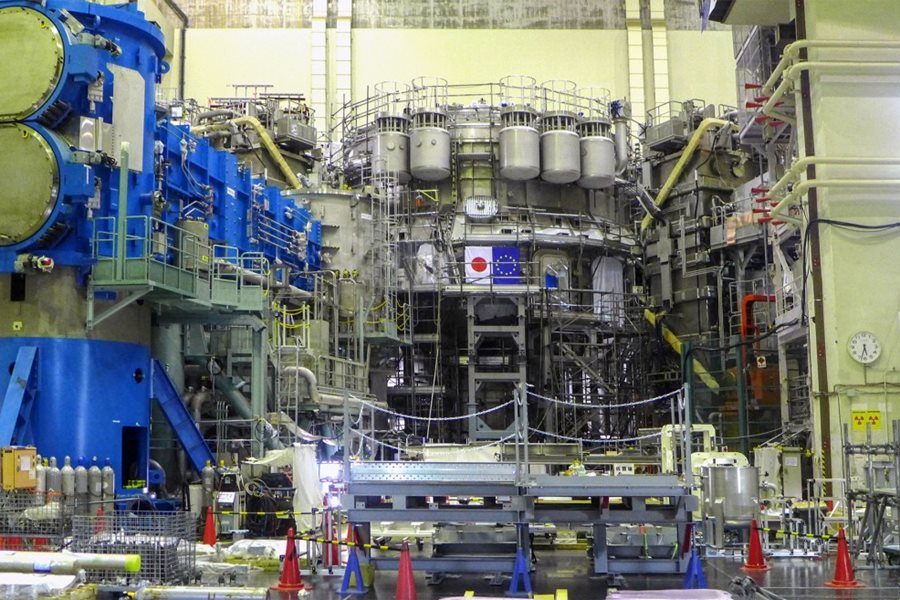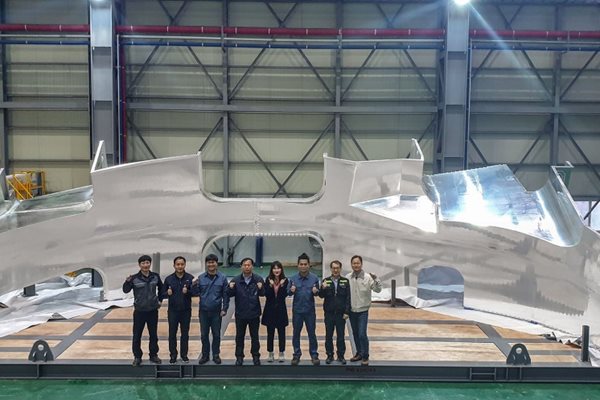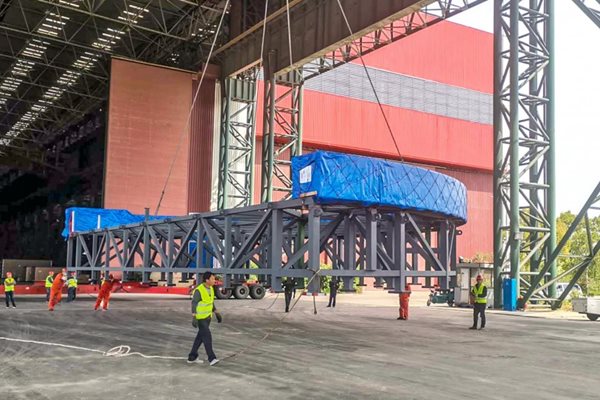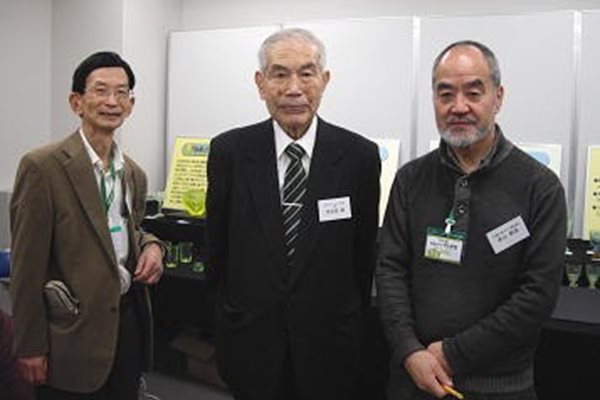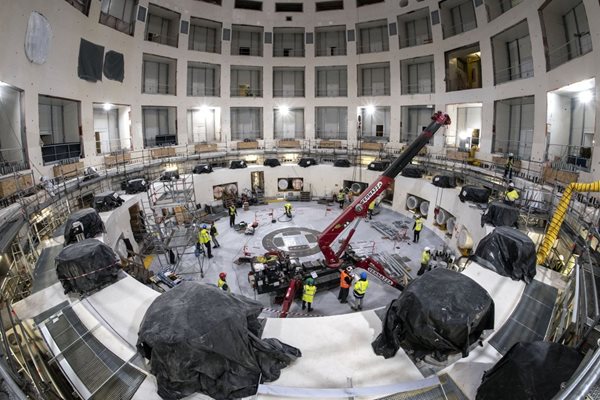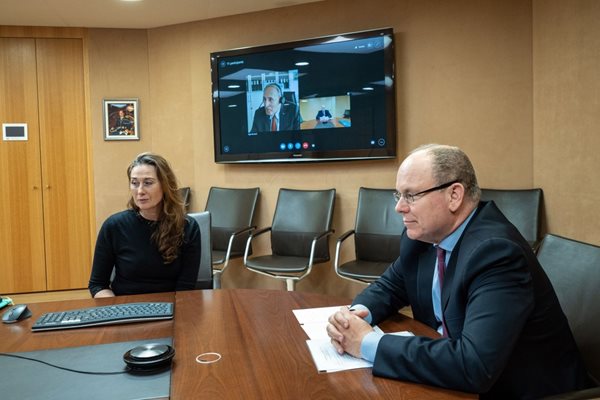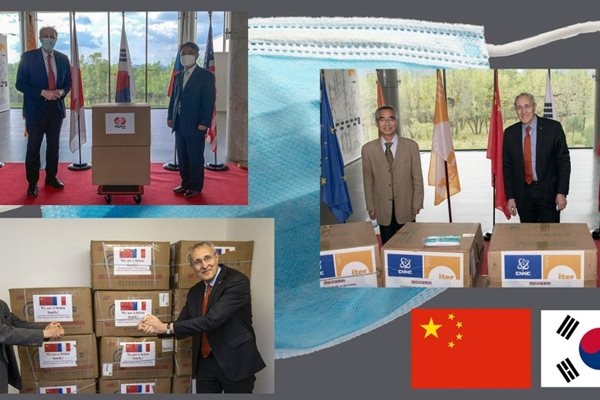
you're currently reading the news digest published from 04 May 2020 to 11 May 2020
featured6
image1
press2
featured
Fusion world | Japan and Europe complete the assembly of JT-60SA
The JT-60SA fusion experiment in Naka, Japan, is designed to explore advanced plasma physics in support of the operation of ITER and next-phase devices. After seven years of assembly, the project—financed and executed jointly by Europe and Japan—is ready for commissioning. In autumn 2020, five years before ITER is scheduled to begin operating, an upgraded tokamak experiment in Japan will celebrate its First Plasma. Like ITER, it is a magnetic confinement fusion device, with a tokamak about half the size of ITER's. JT-60SA (for 'Super Advanced') is part of the Broader Approach¹, a joint program of fusion research and development agreed and co-financed by the European Atomic Energy Community (Euratom) and the government of Japan (represented by its Ministry of Education, Culture, Sports, Science and Technology, MEXT). The upgraded device replaces a tokamak experiment that operated at the Naka Fusion Institute from 1985 to 2008 (first as JT-60, then as JT-60U), and re-uses the site buildings, the neutral beam heating apparatus, and some power supplies and auxiliaries. All core machine components—including vacuum vessel, superconducting magnets, and surrounding cryostat—were re-designed and procured by the implementing teams, the National Institutes for Quantum and Radiological Science and Technology (QST, Japan) and European Domestic Agency for ITER, Fusion for Energy. A satellite in support of ITER JT-60SA is a fully superconducting tokamak capable of confining high-temperature deuterium plasmas for 100-second pulses, with a plasma current up to ~5.5 MA, a large amount of power available for plasma heating and current drive, and a water-cooled divertor designed for heat fluxes of 15 MW/m². It will be able to operate a wide range of plasma shapes (elongations and triangularities) and aspect ratios. With a plasma volume of ~130 m³, the device will take the lead as the world's largest operating tokamak ... until the operation of ITER, that is. Its specific parameters will allow the team based in Naka to conduct research on key physics issues for ITER and the next-phase DEMO such as the development of optimized operational regimes; questions of stability and control, transport and confinement, and high-energy particle behaviour; pedestal and edge physics; plasma-material interaction; fusion engineering; and theoretical models and simulation codes. Even before then, however, the experience of assembling, installing, commissioning and starting up JT-60SA will be highly valuable for the ITER Organization. Thanks to a trilateral arrangement signed in November 2019 between the ITER Organization and the Broader Approach implementing agencies, the ITER Project will benefit from the knowledge and experience acquired by the development of the Broader Approach projects, and in particular JT-60SA. The trilateral arrangement foresees the exchange of data and information; the exchange of scientists, engineers and other technical experts; the exchange of equipment, materials and instrumentation; and jointly performed experimentation, including remote participation. After the positioning of the cryostat top lid in March—the final task of main body assembly—ITER Director-General Bernard Bigot sent these words of congratulations: 'Warmest congratulations to the team's successful completion of the JT-60SA tokamak. It is indeed a magnificent demonstration of QST capacity and of the collaboration established by Europe and Japan, to complete this critical milestone on time. We look forward to the first plasma on JT-60SA this autumn.' Integrated commissioning—a series of functional tests (vacuum pumping, magnet cool down ...) and machine operation with plasmas (including the device's first plasma)—is planned toward the end of the year. See a full report here. For more information, see: Broader Approach, QST, Fusion for Energy. ¹ The Broader Approach Agreement was signed in 2007 between EURATOM and the Government of Japan. Both Parties agreed to continue second-phase Broader Approach activities ("BA phase II") in March 2020.
Manufacturing | Thermal shield milestone in Korea
Six years after the start of fabrication, Korean contractor SFA has completed the last 40° sector of vacuum vessel thermal shield. The stainless steel panels, covered with a 5- to 10-micrometre-thick layer of silver, are packed and ready for shipment. Between the vacuum vessel and the magnets, the vacuum vessel thermal shield will block thermal loads from being transferred from warm components to the superconducting coils and structures that operate at 4.5K. Assembled from many joined panels, with piping for the active circulation of cooling gas (helium gas at 80-100 K), each 40° thermal shield sector will fit one vacuum vessel sector like a glove. A second layer of thermal shield (the cryostat thermal shield) will be installed between the magnets and the cryostat. Both layers must be made "opaque" to thermal radiation. This is achieved by coating all thermal shield surfaces with a material that radiates as little heat is as possible—silver. After plate cutting, bending and forming, welding, final machining, and pre-assembly of the thermal shield, contractors placed the components in a silver bath where, by way of electroplating, a 5- to 10-micrometre-thick layer is deposited. The mass of silver coating on the thermal shield panels is estimated at just under 800 kg total (for a total surface of nearly 2,000 m²). The panels of thermal shielding for vacuum vessel sector #2 were the last to be completed. After successful factory acceptance tests, they have been packed for shipment.
Magnet feeders | On their way from Hefei
The many elements of the magnet feeder system are arriving on site in carefully coordinated sequences aligned with global machine assembly needs. Last month, two large components—in-cryostat feeders that must be installed under the machine—left the Hefei facility of the Institute of Plasma Physics (ASIPP). They will arrive in July. Each of ITER's superconducting magnets—whether one of the 18 toroidal field coils, the 6 poloidal field coils, the central solenoid (6 modules), or the 18 correction coils—must be supplied with electrical power, cryogens and instrumentation. This is the job of 31 superconducting magnet feeders. Designed by the ITER feeder team, procured by the Chinese Domestic Agency, and manufactured at the Institute of Plasma Physics (ASIPP), the feeders travel 30 to 50 metres from the "warm" exterior environment outside the machine and cryostat in to the "cold" superconducting magnets operating at minus 270 °C. Given their size, each feeder will be delivered to ITER in three fully instrumented segments. Coil terminal boxes, situated far from the machine, house warm-to-cold electrical transition equipment, remote control helium supply valves, and sensors for coil instrumentation). Cryostat feed-throughs pass through the concrete bioshield and into the vacuum environment of the cryostat. In-cryostat feeder segments connect directly to the coils. Inside of each segment, are many high technology components that are needed to relay essential services to the magnets: high-temperature superconducting current leads, cryogenic fluid transport pipes, high- and low-voltage instrumentation conduits, and busbars. The work to join the segments will be carried out by trained contractors on site and closely supervised by the ITER Organization. On 21 April, in-cryostat feeder segments for one bottom correction coil and one side correction coil were picked up from the ASIPP facility in Hefei for transport to Shanghai. Weighing 21 tonnes and 18 tonnes respectively and measuring 16 to 19 metres in length, the components will leave China for France next month.
In memoriam | Ken Tomabechi, a leading figure in fusion
The ITER Organization has learned that Ken Tomabechi, a well-known member of the international fusion community, passed away at 91 years of age on 24 April 2020. After degrees in science and philosophy, Dr Tomabechi began his career in nuclear fission at the Japan Atomic Energy Research Institute (JAERI), where he contributed to the development and construction of early fission reactors. An interest in fusion energy led him to participate in the international design effort toward INTOR, a fusion engineering test reactor, and then—in the early 1980s—to the effort underway to construct the JT-60 tokamak in Naka, Japan. He served successively as the Director of JT-60 Construction Department, and the Director General of the JAERI Naka Fusion Research Establishment. In 1988, in Garching, Germany, conceptual design activities for ITER were beginning under the auspices of the International Atomic Energy Agency (IAEA), with approximately 50 experts representing Europe, Japan, Russia, and the United States. Dr Tomabechi was invited to lead the activities as Director until their completion in 1990. (See an ITER concept paper that he authored in 1988, and an overview of the concluded design activities that he published in 1991.) In 1994, the ITER Council appointed him Chair of the Special Review Group to review the technical, social, safety and environmental requirements for siting the ITER Project—a task that he successfully concluded in July 1995. Jean Jacquinot, former Director of the European tokamak JET and current Senior Advisor to the ITER Director-General, remembers Dr Tomabechi with fondness. 'I met Ken Tomabechi several times when he was the director of the ITER conceptual design activities in Garching. He led this effort with great finesse and efficiency. Discreet, but highly sociable and friendly, it was a joy to talk to him on any cultural subject. He was deeply competent on many topics but conversation with him would often move toward a true passion of his—uranium glass. He had an impressive collection, and he wrote a beautifully illustrated book on the subject that is even now a reference on the topic. We will very much miss a friend who was a highly cultivated gentleman.' Dr Tomabechi was a member of the Japan Atomic Energy Society (and recipient of the 1977 Outstanding Technology Achievement award), and of the Japan Society Plasma Science and Nuclear Fusion Research. In 2000, he received the Fusion Power Associates Distinguished Career Award in recognition of his many accomplishments. His many years of leadership in the fusion program in Japan and his essential contributions to the ITER Project and to international collaboration on fusion will be remembered.
Image of the week | Feel the energy
The ITER machine is not assembled yet and First Plasma is still more than five years away, but an intense flux of energy is already palpable inside the Tokamak pit. Like a venue being prepared for a spectacular event, the vast circular space that will soon receive the first machine components is being cleaned, its main systems and features inspected and double-checked. Let's take in and enjoy this image—soon, it will only live in memories.
Monaco Fellows | An investment in the future
Ever since the Monaco-ITER postdoctoral fellowship program was launched in 2008, His Serene Highness Prince Albert II of Monaco has met with the five young scientists that are selected every two years to study research topics related to ITER. This year, due to the pandemic, the planned live meeting was not possible. But there are other means of connecting and exchanging... So on Monday 11 May, from the Prince's Palace in Monaco, Prince Albert logged in by Skype to meet Joyeeta Sinha from India, Jae-Sun Park from Korea, Jonathan Coburn from the USA, Satoshi Togo from Japan and Javier Artola from Spain, and to hear about their research at ITER. 'This is not just make-up work,' as moderator Tim Luce, Head of Science, Controls & Operation, stated. 'This is substantial work in support of ITER. So your contribution is a real investment into our future. This is the generation that will make fusion energy a reality.' ITER Director-General Bernard Bigot expressed his gratitude towards Prince Albert for his continuous support over the past twelve years and six generations of Monaco-ITER Fellows (a seventh will begin at ITER later this year). In return, he received thanks for 'a wonderful moment sharing all this information,' as the Prince underlined once more his personal attachment to this project. 'We will continue to pursue our contribution through this fellowship program, despite the difficult economic times ahead. This is indeed an investment in the future.'
